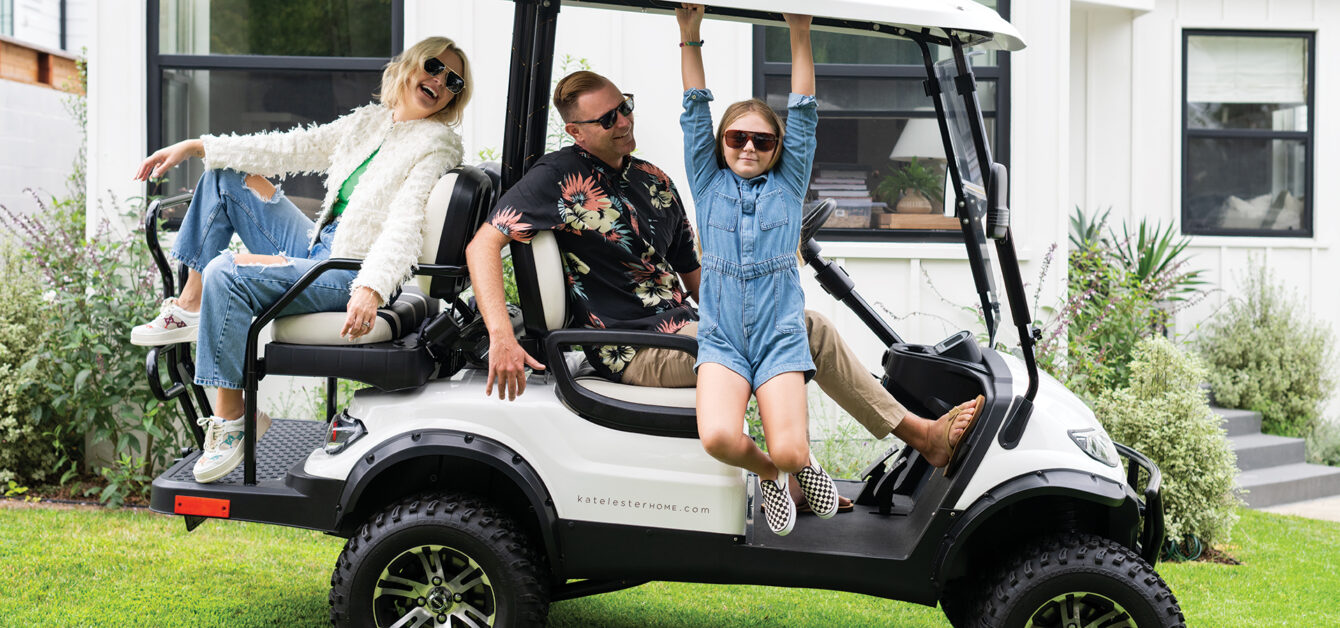It’s a Sunday morning, and Kate Lester is talking to me on the phone from her hotel room before heading out to design meetings at the Las Vegas Market. The Hermosa Beach–based interior designer—who has amassed a roster of high-profile clients including professional athletes, graced the pages of House Beautiful and Architectural Digest, and launched a rug collection with Jaipur Living—is still networking, attending trade shows and taking one-on-one design meetings.

For the self-proclaimed “design school dropout” and “hustler,” this is all a no-brainer. “There’s so much behind the scenes. It’s underestimated what it takes to create a successful brand and business,” says Kate. “It’s a lot of networking and lunches, and I’m still networking today and building relationships. Someone said, ‘You have to stay top of mind, and you have to be present.’ That’s always important to me—it’s just who I am.”
For the West Torrance native, creative director, and CEO of her eponymous design firm and Kate Lester Home stores in Hermosa Beach and Manhattan Beach, the circuitous road map to becoming an interior designer was far from planned, or easy.
“My mom was a single mom. She worked so hard as a flight attendant and always made sure we—my younger sister, Molly, and me—had a great life,” recounts Kate. “It was always really important that I was going to be a business lady who worked in one of those downtown high-rises. I remember reading Cosmopolitan and stories on transitioning your outfits from day to night, and my girlfriends and I would talk about this. I was going to work downtown and do something where I had a briefcase and wore high heels. That’s all I knew.”
Though she vividly remembers single-handedly rearranging the entire first floor of her childhood home one day while her mom was at work, she never entertained the thought of a career in interior design. “My mom was super creative—every room had wallpaper, and she put fabric on the walls before that was even a thing. I firmly believe that I get that from her,” says Kate. “But I’m very practical. Because we didn’t come from a wealthy family, I didn’t think I could make money being an interior designer. It wasn’t my world or anyone’s world I knew, and it wasn’t even on my radar. In my world, you were going to be a doctor, a lawyer, a teacher or a nurse.”

A few years later, while at the University of Southern California studying business and marketing, she discovered other career options. “By then, I thought it was too late because I was on track to work in corporate America and in business,” adds Kate.
Upon graduating, she landed what she thought would be her dream marketing job with a corner office at a risk management company. But after working there for a year, she discovered it was anything but. So she quit and got a job at Sharkeez in Manhattan Beach in 2005.
“My mom, who was all about living your dream and not being unhappy, was like, ‘Good for you,’ and my grandmother was like, ‘Oh, dear.’ So it was not a popular idea,” recalls Kate. “Even my friends’ parents tried to talk me out of it. My best friend’s mom sat me down and said, ‘This is the worst decision you’ve ever made.’ But I was thinking, ‘No, I’m going to figure it out. I just know I can’t do that job—with the structure and the minutia—anymore.”
At Sharkeez, Kate was the designated “wristband/keg girl/promo girl” and ended up meeting her now-husband, AJ, there on Lifeguard Night (he’s Southern Section chief lifeguard). At the same time, Kate was taking classes at Otis College of Art and Design.
“I realized that if I could just get enough interior design knowledge, I could go work for a design firm and learn what they were looking for and what I’d need to know,” adds Kate. “I’d need to know how to read building plans, which I already kind of knew because my grandfather was a contractor. And I’d need to know AutoCAD or architectural software, and I could take these classes first. Then I could at least get a job while taking all the other classes at night. At this point I was working as many jobs as I could to pay for school and rent. So the journey was not glamorous.”

After taking on side jobs designing rooms for friends, Kate worked at Ethan Allen for a year to learn everything she could about retail and furniture. She ultimately landed her first interior design job at Mark Cutler Design in West Hollywood.
“I was their sample library girl, and it was my big break in the sense that it was real design,” says Kate, who was living near the office at the time. “Mark was an architect in Australia before he moved to America, so he was the perfect person to learn from. I got to do an entire project by myself, and I really learned I could do this.”
Kate and AJ got married and moved to South Redondo for his job promotion. They made a plan that she would launch her own design business in 2011 and work from their guest room. “The next thing you know, I have two assistants, an office down the street, and I got two projects,” adds Kate. “My first client was one of the partners at Sharkeez, who bought a beach house and wanted me to furnish it. Talk about a full-circle moment. It’s one of those things where you think, ‘Did I make the right decision?’ And then that phone call comes in, and we hit the ground running from there.”
Twelve years later, Kate’s California-influenced aesthetic and penchant for vintage and collected artwork and objects have set her apart. “You come into your own as you get more confident,” explains Kate. “In the beginning, I wanted to create spaces that my clients liked. I’m at the point now where I want to create spaces that are interesting, curated, fun and unique. I’m so tired of the same things everywhere, and I want to be different. I want people to talk about the spaces I design. It’s about pushing boundaries all the time and not staying where we feel comfortable.”

One of the ways Kate breaks out of the comfort zone is by incorporating what she calls “the weird.” She explains: “We have these words in our office when the design isn’t coming together: ‘This is flat, off or too decorator-y. I need a weird thing.’ Most of the time, it’s a vintage thing. A lot of what’s happening in our design world now looks like a catalog, and that’s because everything is new. The weird—collected or new—makes you think, ‘What is that?’ It makes you look again. I want things that are a little off and a little weird: What’s the one thing that’s going to make people do a double take? We want each room to have its own little story. Any room can be pretty; I want to make it interesting. I think that’s where vintage goes a long way.”
Kate, who has an 8-year-old daughter, says she’s not slowing down at all. In some ways, she’s just getting started. There’s talk of expanding and opening more retail stores and another potential brand collaboration.
“There’s no way I can do anything else,” says Kate. “I love what I do every day when I wake up. In the end, when we install someone’s home and I show them, and they cry—and they cry every time; we have a running record that there has not been a non-crier yet in all the 12 years!—then I get in my car and think, ‘Yes! This is what I do and what I’m naturally good at. It’s not work. This is my gift.’ I just had to figure it out, and my business background has made me flourish. So there are no wrong choices.”

Find What Resonates
First and foremost, look for what speaks to you. Don’t buy things because you saw them on HGTV or heard they will be valuable. Buy what you love and what you are drawn to.
When it comes to artwork, I am always drawn to a good black-and-white charcoal sketch or line drawing because I think they are classic and very easy to integrate into any existing art collection. I am also a sucker for a vintage oil portrait. There is something so soulful about seeing the world through someone else’s eyes. My husband will often say, “Why are we buying that? Who is that?” And I will say, “I don’t know, but I am calling him Frank and he’s going on the mantle.”
Do Some Digging
I have found all of my best pieces in the back or the bottom of shelves or boxes of loose artwork. The stuff in the front is always the most expensive anyway.
Think in Multiples
Once I found a box of a series of vintage screen prints that by themselves were not all that interesting. But after I framed them individually and hung them in a large grouping in a stairway together, they became much more impactful visually.
Look Ahead
Don’t get too hung up on frames or glass. I can’t tell you how many times I have bought something and popped it in a new frame from Michael’s or Target and given it a completely new life and look. I’ve even hung a bare canvas on a gallery wall without a frame.
Start a Conversation
Look for conversation starters when it comes to accessories or accent pieces. I purchased a vintage mid-century carved wood-and-brass, pelican-shaped desk lamp at a thrift shop years ago. It was so interesting and unique; I knew I had to have it for my office. I don’t think I’ve ever turned it on, but every time I walk into my office it makes me smile. I can’t tell you how many people have asked about it. I have two other lamps in the room, and no one has ever asked about those.

Long Beach Antique Market
I love LBAM for artwork and textiles. I’ve taken colorful textiles I’ve found there and framed them, turned them into pillows and used them as throws.
Stars Antique Market
It’s a smaller, more manageable spot for first-timers, but the prices are incredible. Lots of nautical and coastal-inspired items.
1stDibs.com
This is an online shopper’s paradise, but be prepared to pay a premium. I shop here when I am looking for specific period pieces or styles.

Inspect Thoroughly
Look for stains and mold on artwork and mats and canvases. Yes, it happens. Vintage means old.
Check For Termites
When buying vintage or imported wood pieces, look for termite holes. Trust me on this one. They move quickly to other surrounding wood pieces, and it isn’t pretty.
When In Doubt, Buy
A lot of people say to avoid overpaying, but I often think that when you have a good eye, you need to get the items when you can. And if you think the price is fair, just buy it.










